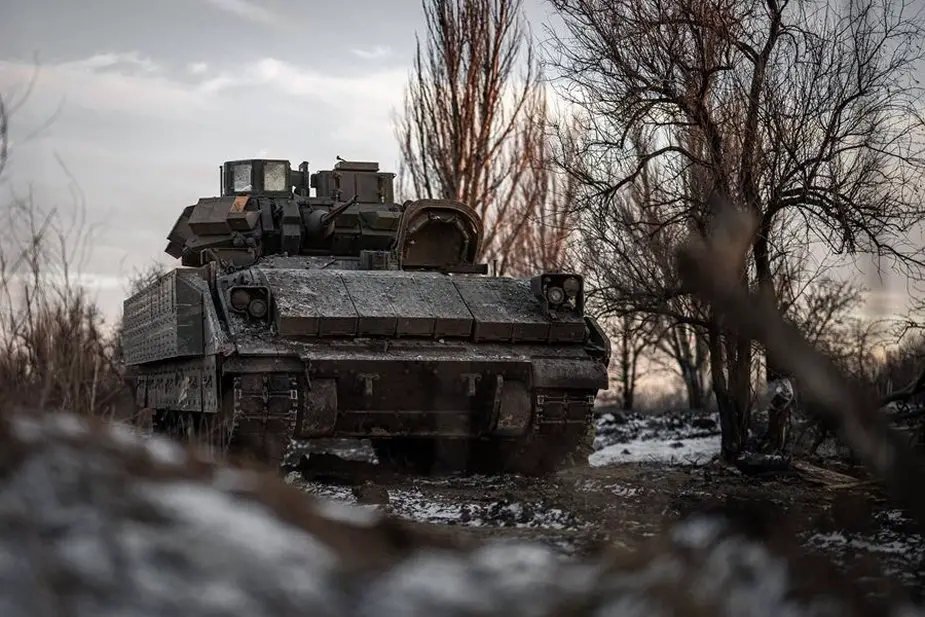Europe nearly doubles its arms imports with a 94% increase
The Stockholm International Peace Research Institute (SIPRI) has unveiled the latest data on the international arms trade. According to the report released on March 11, 2024, Europe has nearly doubled its imports of major arms between the 2014-2018 and 2019-2023 periods, marking a dramatic increase of 94%. This trend highlights a shift in European states' posture in response to global security challenges, particularly by heavily sourcing from the United States, which now accounts for 55% of their arms imports, up from 35% in the previous period.
Follow Army Recognition on Google News at this link

One of the 190 Bradley IFVs was delivered to Ukraine in different batches (Picture source: Ukrainian MoD )
Simultaneously, the landscape of arms exports is undergoing significant changes. The United States and France have seen their arms exports increase by 17% and 47%, respectively, reinforcing their positions in the global market. The United States, in particular, continues to dominate the sector as the world's largest arms exporter, delivering major weapons to 107 states, a record number. This expansion of American exports is part of a foreign policy strategy aimed at maintaining and expanding their global influence.
Conversely, Russia is experiencing a marked decline, with its arms exports halving, relegating it to the third-largest arms exporter behind France. This collapse in Russian exports is characterized by a significant reduction in trade with its traditional partners, notably India and China, although these countries remain among the main recipients of its armaments. While Russia exported major arms to 31 states in 2019, it exported to only 12 in 2023.
France has become the world's second-largest arms exporter for the first time. Of these exports, 42% are destined for states in Asia and Oceania, and 34% for states in the Middle East. India is the primary recipient of French exports, accounting for nearly 30% of its exports. This figure is largely explained by the delivery of combat aircraft to India, Qatar, and Egypt.
Within Europe, Ukraine has become the largest importer of arms between 2019-2023 and the fourth in the world, as nearly 30 states have supplied it with weapons. Following the United States, Germany and France are the next largest suppliers, accounting for 6.4% and 4.6% of imports, respectively.
Europe is not only a major importer but also an exporter, responsible for about one-third of global arms exports. This duality underlines the region's significant military-industrial capability and its strategic position in international arms exchanges. Overall, the United States and Western European states account for 72% of total global arms exports in 2019-2023, compared to 62% between 2014-2018.
Beyond Europe, the SIPRI report highlights specific regional dynamics. Asia, Oceania, and the Middle East continue to attract significant quantities of arms, with nine of the top ten global importers located in these regions.
The largest share of arms transfers is destined for Asia, with 37% of major transfers. Although this represents a decline from 2014-2018, the United States accounts for 34% of arms imports into the region, compared to 19% for Russia and 13% for China. India retains its position as the world's top arms importer, although the source of its imports has shifted, with a significant reduction in the share from Russia in favor of the United States. Pakistan has also increased its arms imports by 43% from 2019-2023, with China as its main supplier.
Similarly, Japan's imports have increased by 155%, and South Korea's by 6.5%. In contrast, China's imports have decreased by 44%, mainly due to replacing imported weapons, mostly from Russia, with locally produced systems.
The Middle East accounts for 30% of international arms transfers, with three Middle Eastern states, namely Saudi Arabia, Qatar, and Egypt, among the top 10 importers in 2019-2023. Saudi Arabia is the world's second-largest arms importer, accounting for 8.4% of global arms imports during this period, although imports have dropped by 28% compared to 2014-2018. Qatar has almost quadrupled its arms imports, making it the third-largest global arms importer.
This redistribution of arms flows reflects deep changes in alliances and security concerns on a global scale. The motivations behind these massive arms imports are diverse, including the desire to strengthen transatlantic relations, technical, military, and financial considerations, and above all, responses to ongoing regional tensions and conflicts. Notably, there's a strong demand for air defense systems in Europe, spurred by hostilities in Ukraine. Furthermore, the Middle East continues to import significant quantities of arms, primarily from the United States and Europe, reflecting the conflicts and tensions that shake the region.
Defense News March 2024
- Hits: 1819
















